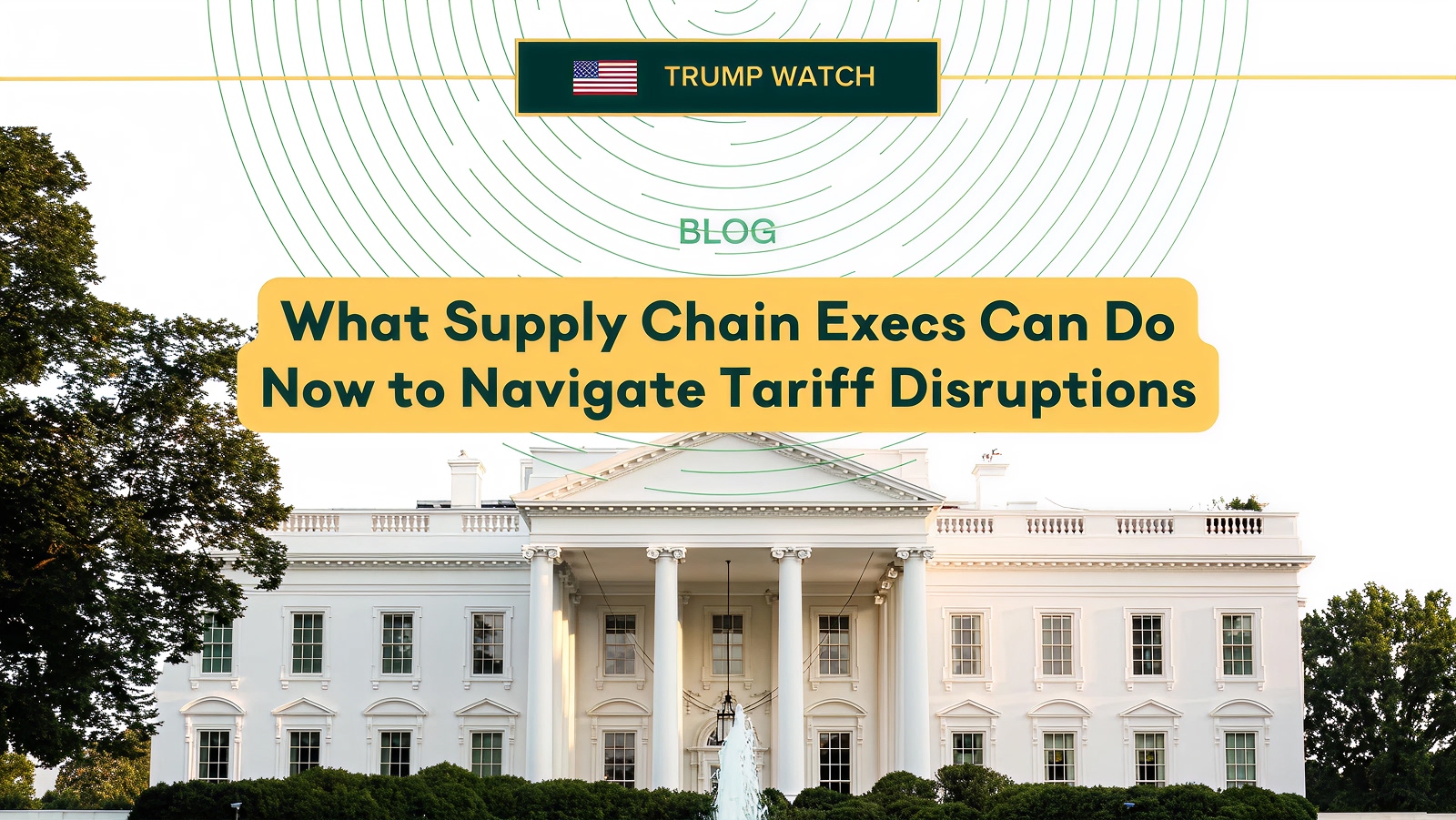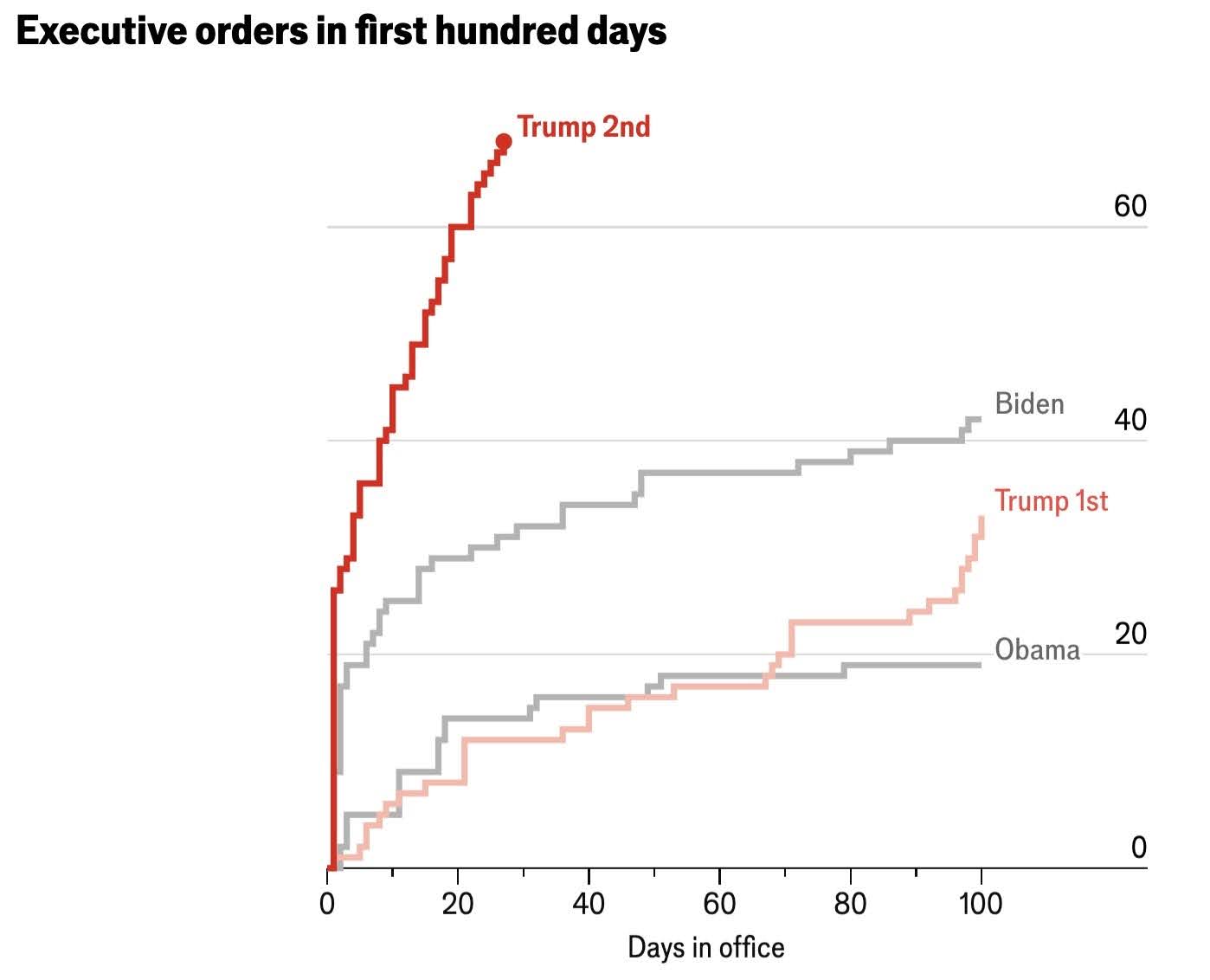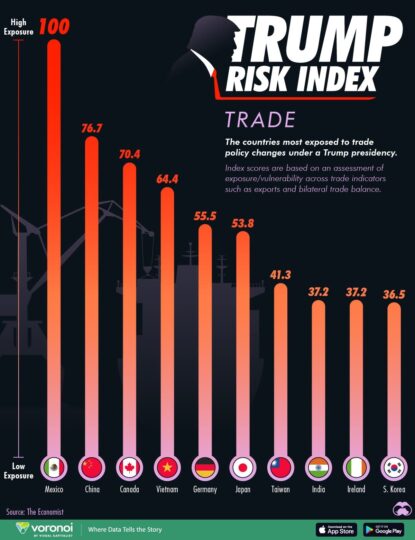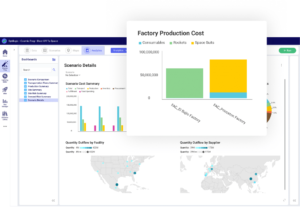
Discover actionable insights for supply chain executives to mitigate risks and adapt strategies amidst tariff disruptions under the Trump administration's policies.
Published by
Published on
February 25, 2025





JTVCYXV0aG9yX2luZm8lNUQ=
In the first month of his presidency, Donald Trump has signed 65 executive orders—including several policies which could influence global supply chains for years to come. We’ve been following The Economist’s coverage of the slew of policy updates, including its “Trump Approval Tracker”. So inspired were we by The Economist’s commentary on Trump’s first 100 days that we decided to launch our own “Trump Watch” series which will follow the Economist’s content with our own supply chain design perspective.

Source: The EconomistRecent U.S. tariff policies have forced executives to confront pressing questions:
The global trade environment is increasingly unpredictable, with shifting policies and rising tariffs creating new challenges for supply chain leaders. However, as our CEO Don Hicks says, “Trying to guess what the government will do is a fool’s errand. Change isn’t something new—you must reanalyze and adjust constantly.”
Being able to respond to change—in the short- and long-term view—is the new basis for competitive advantage. If you can’t shift and adjust to cost changes like tariffs, your competitors will overtake you. Here’s how to get the upper hand on Trump’s tariffs with intelligent supply chain design.
The latest government official communications highlight plans to impose tariffs on imports to protect national manufacturing, maintain a competitive edge, and strengthen the U.S. negotiation stance globally. An additional 10% tariff on Chinese imports, raising the total to 30%, has already been confirmed. These taxation policies will impact sourcing and manufacturing decisions for U.S. companies, as China has long been a cornerstone of global supply chain cost reduction initiatives. High tariffs could push businesses to evaluate nearshoring due to their effect on competitive pricing, lead times, and supply chain control. Tariffs have also been proposed for key trade partners Mexico and Canada, with 25% rates likely to be implemented soon. These tariffs could disrupt U.S. companies that rely on Mexican manufacturing or Canadian-based tech talent.

Source: Visual CapitalistFor global trade, new policy may lead Mexico and Canada to seek new trade partners, altering international trade systems and supply chain dynamics. These changes will ripple through industries, forcing adjustments in supply chain flows and competitiveness. The government is also reviewing trade partners individually to adjust tariffs based on specific relationships, which could further impact supply chain strategies. Companies will need to carefully evaluate their operations to stay competitive while managing increased costs. This evolving situation calls for a reassessment of global sourcing and manufacturing decisions to adapt to changing trade policies. Businesses must weigh trade-offs to minimize risks and align with the new economic environment. In addition to tariffs, the administration has opened a conversation about reducing or even eliminating income taxes, which could shift consumer behavior in the U.S. Lower taxes would boost disposable income, encouraging higher spending and offsetting some of the rising costs from tariffs. This approach aims to balance the economic impact of trade changes by increasing consumer purchasing power. However, the long-term effects on overall economic stability and supply chain competitiveness remain uncertain. https://youtu.be/S1vRy7_-SJM?si=UNCsQO8jz1axXUtE
For supply chains tariff changes have multiple impacts that we can classify into three different categories:
Following COVID, the drive to increase resilience of global supply chains caused U.S. companies to diversify their supplier/vendor relationships and evaluate nearshoring—mostly in Mexico and Canada. If sourcing and manufacturing operations are moved from Mexico and Canada, overall production and distribution costs will likely increase. Businesses must ask:
Consumer behavior will shift due to changes in finished goods pricing caused by higher supply chain costs. This shift will require the supply chain to adapt to meet new customer preferences, such as:
Innovation in processes, procedures, packaging, and presentation will be crucial to stand out in the market. This will impact suppliers, manufacturing processes, workforce and training, as well as logistics efforts needed to adapt to the evolving environment. Adaptability and flexibility will be essential as consumer behavior and market conditions continue to change. A responsive supply chain will be better positioned to capitalize on these shifts.
It is expected that tariffs will be levied on US exports by countries affected by the US import tax. This shift will significantly impact target markets for many local products and require efforts to adapt to the changing demand landscape. Key considerations include:
Exploration of alternative markets and competitive advantages in these regions will be critical. Additionally, re-igniting local demand or innovating to find alternative revenue streams will play a key role in balancing the demand shortfall.

Optilogic Cosmic Frog is a supply chain design solution that enables anyone in your company to answer supply chain questions using a shared virtual supply chain model. Using Cosmic Frog, analysts can anticipate tariff impacts, evaluate alternative strategies, and rapidly implement results with easy access for business users.
JTVCYXV0aG9yX2luZm8lNUQ=
In the first month of his presidency, Donald Trump has signed 65 executive orders—including several policies which could influence global supply chains for years to come. We’ve been following The Economist’s coverage of the slew of policy updates, including its “Trump Approval Tracker”. So inspired were we by The Economist’s commentary on Trump’s first 100 days that we decided to launch our own “Trump Watch” series which will follow the Economist’s content with our own supply chain design perspective.

Source: The EconomistRecent U.S. tariff policies have forced executives to confront pressing questions:
The global trade environment is increasingly unpredictable, with shifting policies and rising tariffs creating new challenges for supply chain leaders. However, as our CEO Don Hicks says, “Trying to guess what the government will do is a fool’s errand. Change isn’t something new—you must reanalyze and adjust constantly.”
Being able to respond to change—in the short- and long-term view—is the new basis for competitive advantage. If you can’t shift and adjust to cost changes like tariffs, your competitors will overtake you. Here’s how to get the upper hand on Trump’s tariffs with intelligent supply chain design.
The latest government official communications highlight plans to impose tariffs on imports to protect national manufacturing, maintain a competitive edge, and strengthen the U.S. negotiation stance globally. An additional 10% tariff on Chinese imports, raising the total to 30%, has already been confirmed. These taxation policies will impact sourcing and manufacturing decisions for U.S. companies, as China has long been a cornerstone of global supply chain cost reduction initiatives. High tariffs could push businesses to evaluate nearshoring due to their effect on competitive pricing, lead times, and supply chain control. Tariffs have also been proposed for key trade partners Mexico and Canada, with 25% rates likely to be implemented soon. These tariffs could disrupt U.S. companies that rely on Mexican manufacturing or Canadian-based tech talent.

Source: Visual CapitalistFor global trade, new policy may lead Mexico and Canada to seek new trade partners, altering international trade systems and supply chain dynamics. These changes will ripple through industries, forcing adjustments in supply chain flows and competitiveness. The government is also reviewing trade partners individually to adjust tariffs based on specific relationships, which could further impact supply chain strategies. Companies will need to carefully evaluate their operations to stay competitive while managing increased costs. This evolving situation calls for a reassessment of global sourcing and manufacturing decisions to adapt to changing trade policies. Businesses must weigh trade-offs to minimize risks and align with the new economic environment. In addition to tariffs, the administration has opened a conversation about reducing or even eliminating income taxes, which could shift consumer behavior in the U.S. Lower taxes would boost disposable income, encouraging higher spending and offsetting some of the rising costs from tariffs. This approach aims to balance the economic impact of trade changes by increasing consumer purchasing power. However, the long-term effects on overall economic stability and supply chain competitiveness remain uncertain. https://youtu.be/S1vRy7_-SJM?si=UNCsQO8jz1axXUtE
For supply chains tariff changes have multiple impacts that we can classify into three different categories:
Following COVID, the drive to increase resilience of global supply chains caused U.S. companies to diversify their supplier/vendor relationships and evaluate nearshoring—mostly in Mexico and Canada. If sourcing and manufacturing operations are moved from Mexico and Canada, overall production and distribution costs will likely increase. Businesses must ask:
Consumer behavior will shift due to changes in finished goods pricing caused by higher supply chain costs. This shift will require the supply chain to adapt to meet new customer preferences, such as:
Innovation in processes, procedures, packaging, and presentation will be crucial to stand out in the market. This will impact suppliers, manufacturing processes, workforce and training, as well as logistics efforts needed to adapt to the evolving environment. Adaptability and flexibility will be essential as consumer behavior and market conditions continue to change. A responsive supply chain will be better positioned to capitalize on these shifts.
It is expected that tariffs will be levied on US exports by countries affected by the US import tax. This shift will significantly impact target markets for many local products and require efforts to adapt to the changing demand landscape. Key considerations include:
Exploration of alternative markets and competitive advantages in these regions will be critical. Additionally, re-igniting local demand or innovating to find alternative revenue streams will play a key role in balancing the demand shortfall.

Optilogic Cosmic Frog is a supply chain design solution that enables anyone in your company to answer supply chain questions using a shared virtual supply chain model. Using Cosmic Frog, analysts can anticipate tariff impacts, evaluate alternative strategies, and rapidly implement results with easy access for business users.
Fill out the form to unlock the full content

.png)

.png)
